Life Cycle Analysis Memo: Analysis of LCA Against ISO Standards
VerifiedAdded on 2022/08/17
|5
|1464
|11
Report
AI Summary
This memo analyzes a Life Cycle Assessment (LCA) of road infrastructure and residential neighborhoods, evaluating it against ISO 14040 and ISO 14044 standards. The analysis identifies functional units and key reference flows, examining how the LCA methodology handles multi-functionality in unit processes. The report explores the application of sensitivity analysis to key assumptions, providing evidence for its use in drawing conclusions and making recommendations. The memo highlights the environmental and financial costs considered in the LCA, referencing elements such as investment, energy, replacement, maintenance and cleaning. The unit processes, are further classified into input flows, and output flows by linking them with intermediate flows. The analysis demonstrates how the LCA methodology assesses environmental impacts throughout the life cycle of road infrastructure, offering insights into the potential for environmental performance improvement.
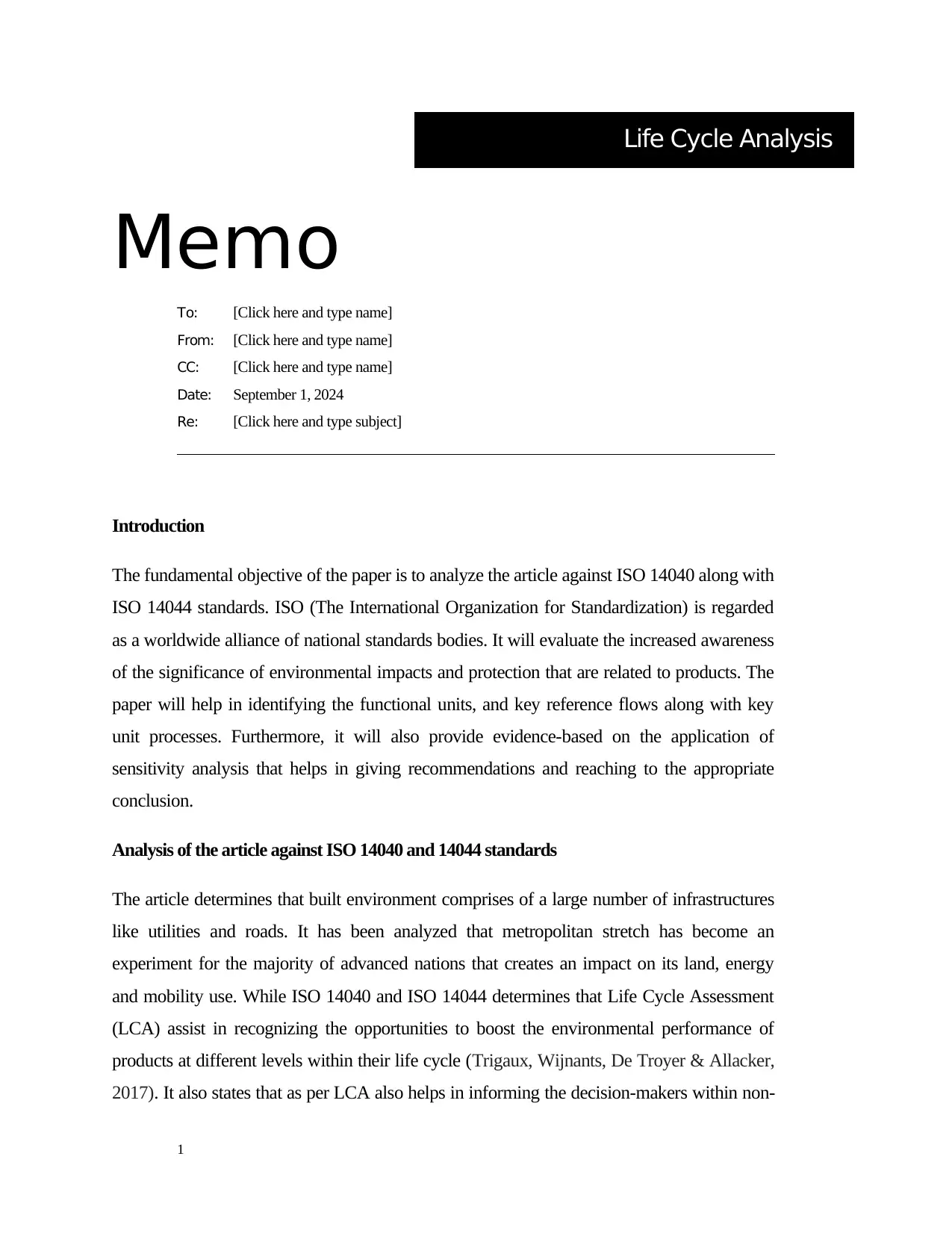
Life Cycle Analysis
Memo
To: [Click here and type name]
From: [Click here and type name]
CC: [Click here and type name]
Date: September 1, 2024
Re: [Click here and type subject]
Introduction
The fundamental objective of the paper is to analyze the article against ISO 14040 along with
ISO 14044 standards. ISO (The International Organization for Standardization) is regarded
as a worldwide alliance of national standards bodies. It will evaluate the increased awareness
of the significance of environmental impacts and protection that are related to products. The
paper will help in identifying the functional units, and key reference flows along with key
unit processes. Furthermore, it will also provide evidence-based on the application of
sensitivity analysis that helps in giving recommendations and reaching to the appropriate
conclusion.
Analysis of the article against ISO 14040 and 14044 standards
The article determines that built environment comprises of a large number of infrastructures
like utilities and roads. It has been analyzed that metropolitan stretch has become an
experiment for the majority of advanced nations that creates an impact on its land, energy
and mobility use. While ISO 14040 and ISO 14044 determines that Life Cycle Assessment
(LCA) assist in recognizing the opportunities to boost the environmental performance of
products at different levels within their life cycle (Trigaux, Wijnants, De Troyer & Allacker,
2017). It also states that as per LCA also helps in informing the decision-makers within non-
1
Memo
To: [Click here and type name]
From: [Click here and type name]
CC: [Click here and type name]
Date: September 1, 2024
Re: [Click here and type subject]
Introduction
The fundamental objective of the paper is to analyze the article against ISO 14040 along with
ISO 14044 standards. ISO (The International Organization for Standardization) is regarded
as a worldwide alliance of national standards bodies. It will evaluate the increased awareness
of the significance of environmental impacts and protection that are related to products. The
paper will help in identifying the functional units, and key reference flows along with key
unit processes. Furthermore, it will also provide evidence-based on the application of
sensitivity analysis that helps in giving recommendations and reaching to the appropriate
conclusion.
Analysis of the article against ISO 14040 and 14044 standards
The article determines that built environment comprises of a large number of infrastructures
like utilities and roads. It has been analyzed that metropolitan stretch has become an
experiment for the majority of advanced nations that creates an impact on its land, energy
and mobility use. While ISO 14040 and ISO 14044 determines that Life Cycle Assessment
(LCA) assist in recognizing the opportunities to boost the environmental performance of
products at different levels within their life cycle (Trigaux, Wijnants, De Troyer & Allacker,
2017). It also states that as per LCA also helps in informing the decision-makers within non-
1
Paraphrase This Document
Need a fresh take? Get an instant paraphrase of this document with our AI Paraphraser
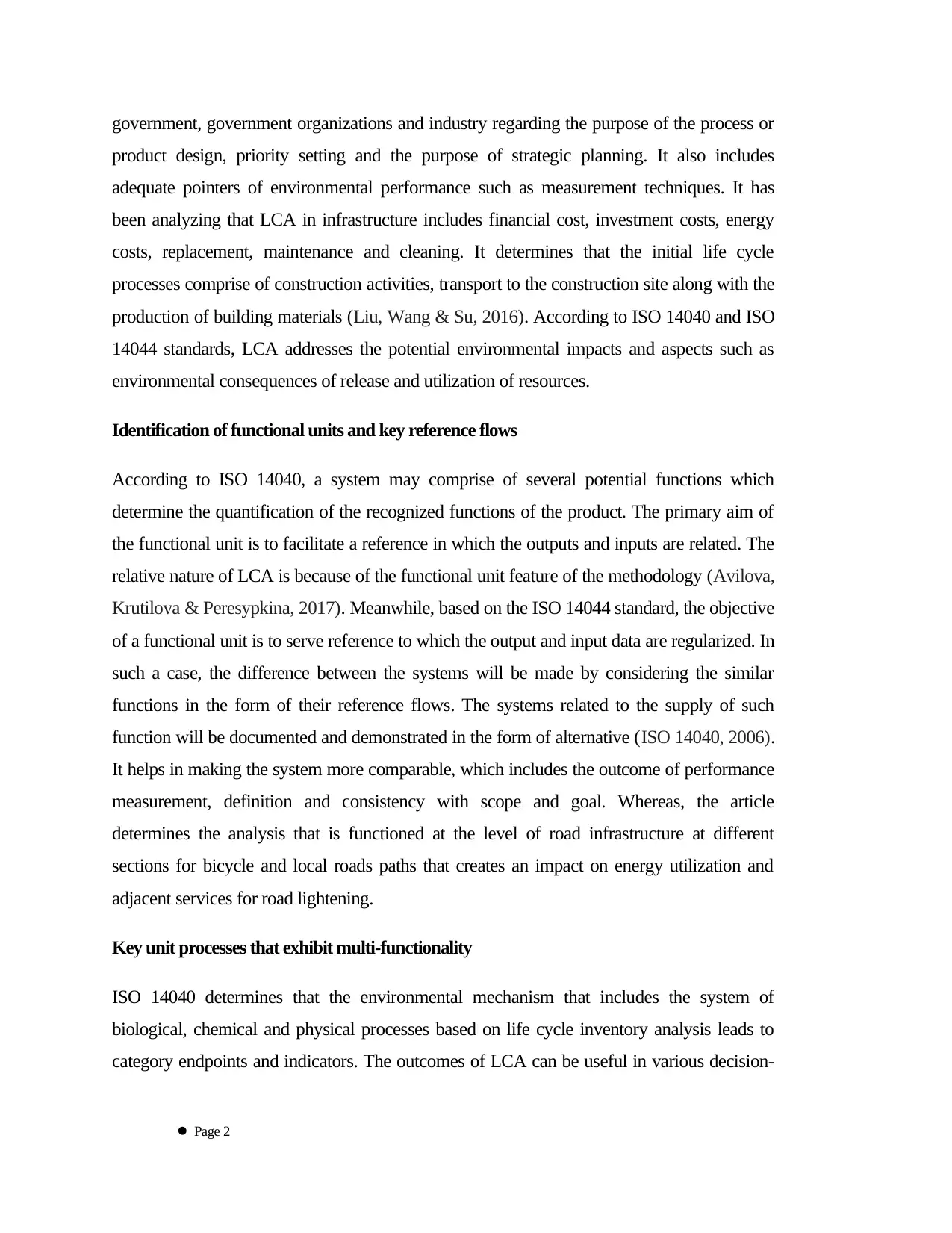
government, government organizations and industry regarding the purpose of the process or
product design, priority setting and the purpose of strategic planning. It also includes
adequate pointers of environmental performance such as measurement techniques. It has
been analyzing that LCA in infrastructure includes financial cost, investment costs, energy
costs, replacement, maintenance and cleaning. It determines that the initial life cycle
processes comprise of construction activities, transport to the construction site along with the
production of building materials (Liu, Wang & Su, 2016). According to ISO 14040 and ISO
14044 standards, LCA addresses the potential environmental impacts and aspects such as
environmental consequences of release and utilization of resources.
Identification of functional units and key reference flows
According to ISO 14040, a system may comprise of several potential functions which
determine the quantification of the recognized functions of the product. The primary aim of
the functional unit is to facilitate a reference in which the outputs and inputs are related. The
relative nature of LCA is because of the functional unit feature of the methodology (Avilova,
Krutilova & Peresypkina, 2017). Meanwhile, based on the ISO 14044 standard, the objective
of a functional unit is to serve reference to which the output and input data are regularized. In
such a case, the difference between the systems will be made by considering the similar
functions in the form of their reference flows. The systems related to the supply of such
function will be documented and demonstrated in the form of alternative (ISO 14040, 2006).
It helps in making the system more comparable, which includes the outcome of performance
measurement, definition and consistency with scope and goal. Whereas, the article
determines the analysis that is functioned at the level of road infrastructure at different
sections for bicycle and local roads paths that creates an impact on energy utilization and
adjacent services for road lightening.
Key unit processes that exhibit multi-functionality
ISO 14040 determines that the environmental mechanism that includes the system of
biological, chemical and physical processes based on life cycle inventory analysis leads to
category endpoints and indicators. The outcomes of LCA can be useful in various decision-
Page 2
product design, priority setting and the purpose of strategic planning. It also includes
adequate pointers of environmental performance such as measurement techniques. It has
been analyzing that LCA in infrastructure includes financial cost, investment costs, energy
costs, replacement, maintenance and cleaning. It determines that the initial life cycle
processes comprise of construction activities, transport to the construction site along with the
production of building materials (Liu, Wang & Su, 2016). According to ISO 14040 and ISO
14044 standards, LCA addresses the potential environmental impacts and aspects such as
environmental consequences of release and utilization of resources.
Identification of functional units and key reference flows
According to ISO 14040, a system may comprise of several potential functions which
determine the quantification of the recognized functions of the product. The primary aim of
the functional unit is to facilitate a reference in which the outputs and inputs are related. The
relative nature of LCA is because of the functional unit feature of the methodology (Avilova,
Krutilova & Peresypkina, 2017). Meanwhile, based on the ISO 14044 standard, the objective
of a functional unit is to serve reference to which the output and input data are regularized. In
such a case, the difference between the systems will be made by considering the similar
functions in the form of their reference flows. The systems related to the supply of such
function will be documented and demonstrated in the form of alternative (ISO 14040, 2006).
It helps in making the system more comparable, which includes the outcome of performance
measurement, definition and consistency with scope and goal. Whereas, the article
determines the analysis that is functioned at the level of road infrastructure at different
sections for bicycle and local roads paths that creates an impact on energy utilization and
adjacent services for road lightening.
Key unit processes that exhibit multi-functionality
ISO 14040 determines that the environmental mechanism that includes the system of
biological, chemical and physical processes based on life cycle inventory analysis leads to
category endpoints and indicators. The outcomes of LCA can be useful in various decision-
Page 2
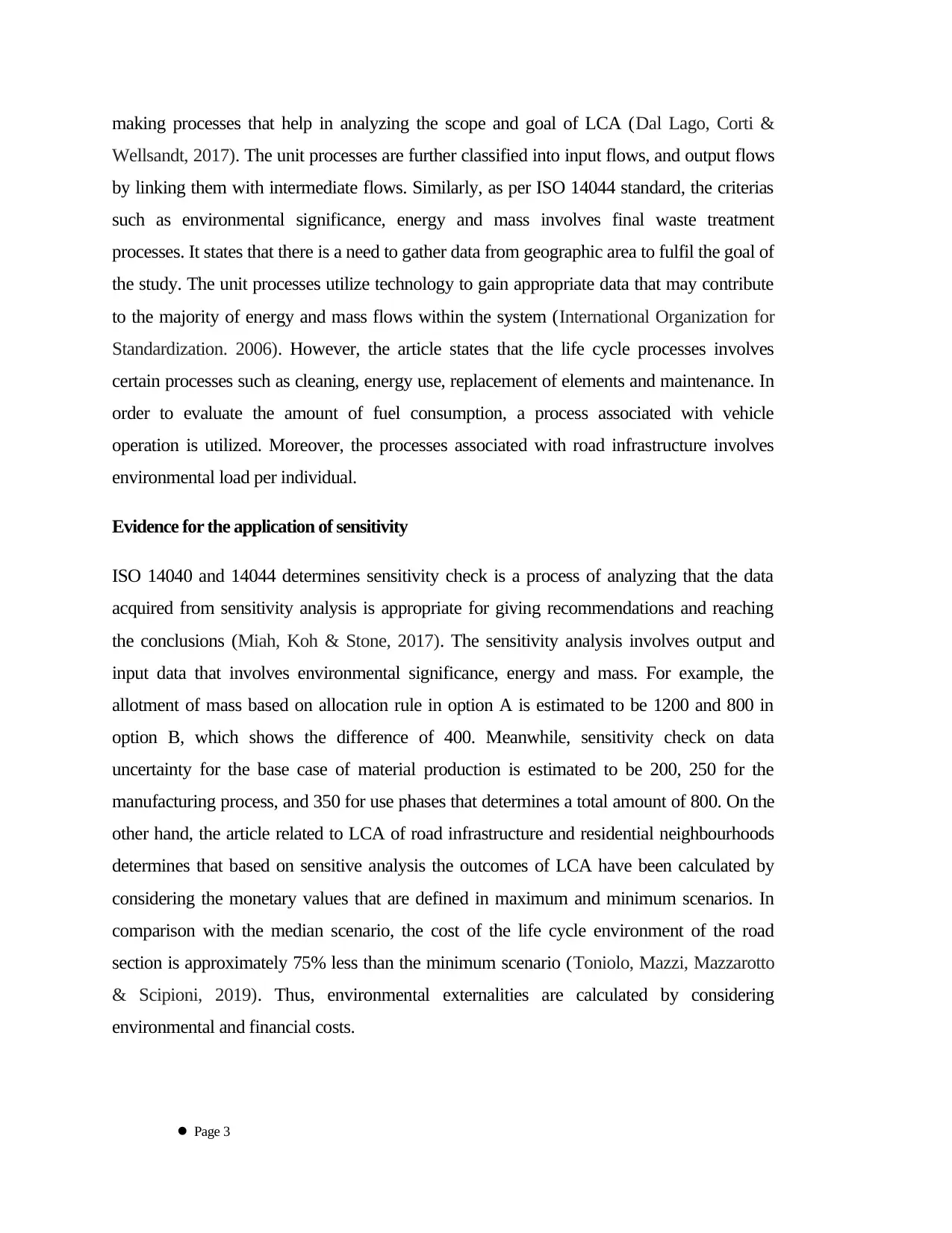
making processes that help in analyzing the scope and goal of LCA (Dal Lago, Corti &
Wellsandt, 2017). The unit processes are further classified into input flows, and output flows
by linking them with intermediate flows. Similarly, as per ISO 14044 standard, the criterias
such as environmental significance, energy and mass involves final waste treatment
processes. It states that there is a need to gather data from geographic area to fulfil the goal of
the study. The unit processes utilize technology to gain appropriate data that may contribute
to the majority of energy and mass flows within the system (International Organization for
Standardization. 2006). However, the article states that the life cycle processes involves
certain processes such as cleaning, energy use, replacement of elements and maintenance. In
order to evaluate the amount of fuel consumption, a process associated with vehicle
operation is utilized. Moreover, the processes associated with road infrastructure involves
environmental load per individual.
Evidence for the application of sensitivity
ISO 14040 and 14044 determines sensitivity check is a process of analyzing that the data
acquired from sensitivity analysis is appropriate for giving recommendations and reaching
the conclusions (Miah, Koh & Stone, 2017). The sensitivity analysis involves output and
input data that involves environmental significance, energy and mass. For example, the
allotment of mass based on allocation rule in option A is estimated to be 1200 and 800 in
option B, which shows the difference of 400. Meanwhile, sensitivity check on data
uncertainty for the base case of material production is estimated to be 200, 250 for the
manufacturing process, and 350 for use phases that determines a total amount of 800. On the
other hand, the article related to LCA of road infrastructure and residential neighbourhoods
determines that based on sensitive analysis the outcomes of LCA have been calculated by
considering the monetary values that are defined in maximum and minimum scenarios. In
comparison with the median scenario, the cost of the life cycle environment of the road
section is approximately 75% less than the minimum scenario (Toniolo, Mazzi, Mazzarotto
& Scipioni, 2019). Thus, environmental externalities are calculated by considering
environmental and financial costs.
Page 3
Wellsandt, 2017). The unit processes are further classified into input flows, and output flows
by linking them with intermediate flows. Similarly, as per ISO 14044 standard, the criterias
such as environmental significance, energy and mass involves final waste treatment
processes. It states that there is a need to gather data from geographic area to fulfil the goal of
the study. The unit processes utilize technology to gain appropriate data that may contribute
to the majority of energy and mass flows within the system (International Organization for
Standardization. 2006). However, the article states that the life cycle processes involves
certain processes such as cleaning, energy use, replacement of elements and maintenance. In
order to evaluate the amount of fuel consumption, a process associated with vehicle
operation is utilized. Moreover, the processes associated with road infrastructure involves
environmental load per individual.
Evidence for the application of sensitivity
ISO 14040 and 14044 determines sensitivity check is a process of analyzing that the data
acquired from sensitivity analysis is appropriate for giving recommendations and reaching
the conclusions (Miah, Koh & Stone, 2017). The sensitivity analysis involves output and
input data that involves environmental significance, energy and mass. For example, the
allotment of mass based on allocation rule in option A is estimated to be 1200 and 800 in
option B, which shows the difference of 400. Meanwhile, sensitivity check on data
uncertainty for the base case of material production is estimated to be 200, 250 for the
manufacturing process, and 350 for use phases that determines a total amount of 800. On the
other hand, the article related to LCA of road infrastructure and residential neighbourhoods
determines that based on sensitive analysis the outcomes of LCA have been calculated by
considering the monetary values that are defined in maximum and minimum scenarios. In
comparison with the median scenario, the cost of the life cycle environment of the road
section is approximately 75% less than the minimum scenario (Toniolo, Mazzi, Mazzarotto
& Scipioni, 2019). Thus, environmental externalities are calculated by considering
environmental and financial costs.
Page 3
⊘ This is a preview!⊘
Do you want full access?
Subscribe today to unlock all pages.

Trusted by 1+ million students worldwide
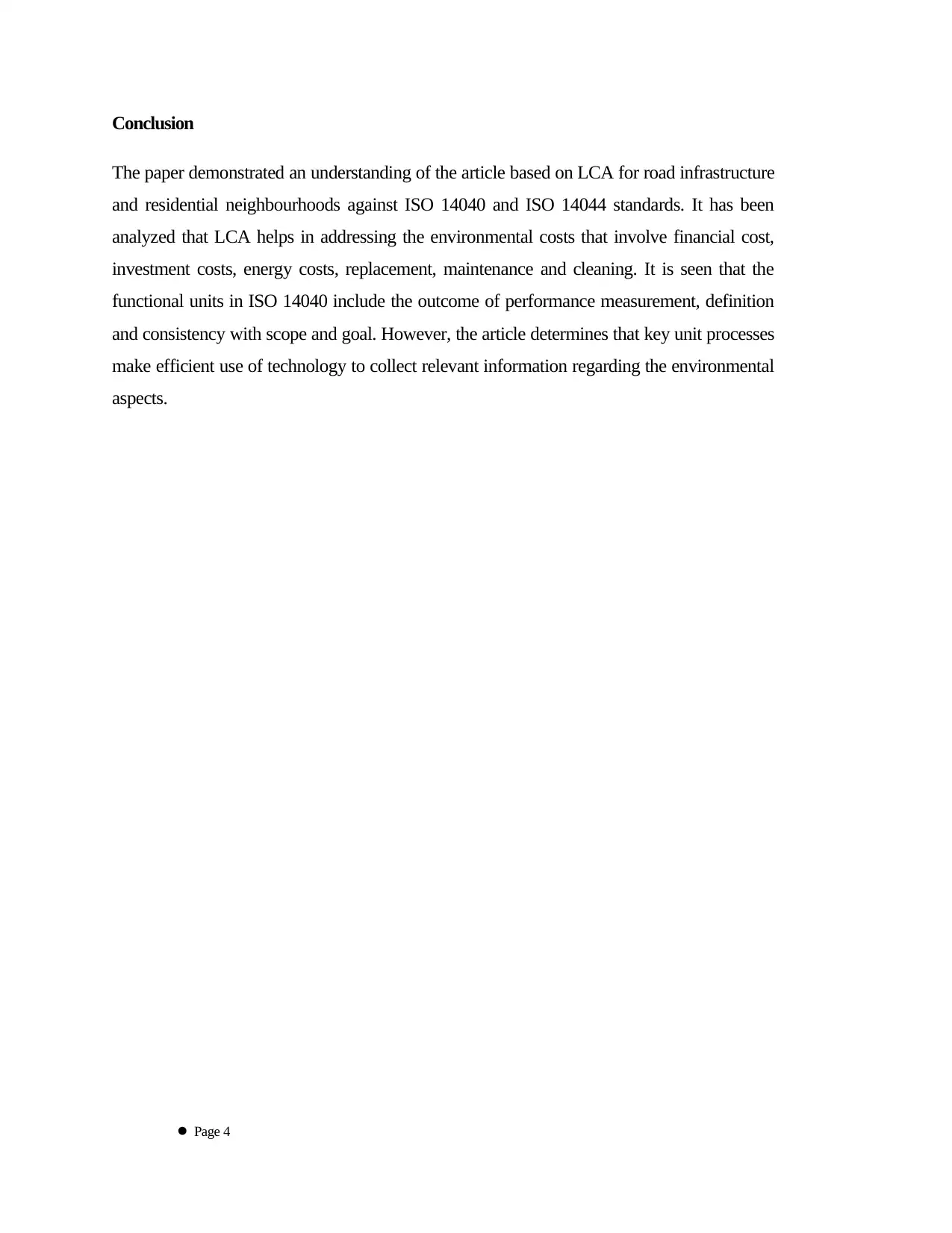
Conclusion
The paper demonstrated an understanding of the article based on LCA for road infrastructure
and residential neighbourhoods against ISO 14040 and ISO 14044 standards. It has been
analyzed that LCA helps in addressing the environmental costs that involve financial cost,
investment costs, energy costs, replacement, maintenance and cleaning. It is seen that the
functional units in ISO 14040 include the outcome of performance measurement, definition
and consistency with scope and goal. However, the article determines that key unit processes
make efficient use of technology to collect relevant information regarding the environmental
aspects.
Page 4
The paper demonstrated an understanding of the article based on LCA for road infrastructure
and residential neighbourhoods against ISO 14040 and ISO 14044 standards. It has been
analyzed that LCA helps in addressing the environmental costs that involve financial cost,
investment costs, energy costs, replacement, maintenance and cleaning. It is seen that the
functional units in ISO 14040 include the outcome of performance measurement, definition
and consistency with scope and goal. However, the article determines that key unit processes
make efficient use of technology to collect relevant information regarding the environmental
aspects.
Page 4
Paraphrase This Document
Need a fresh take? Get an instant paraphrase of this document with our AI Paraphraser
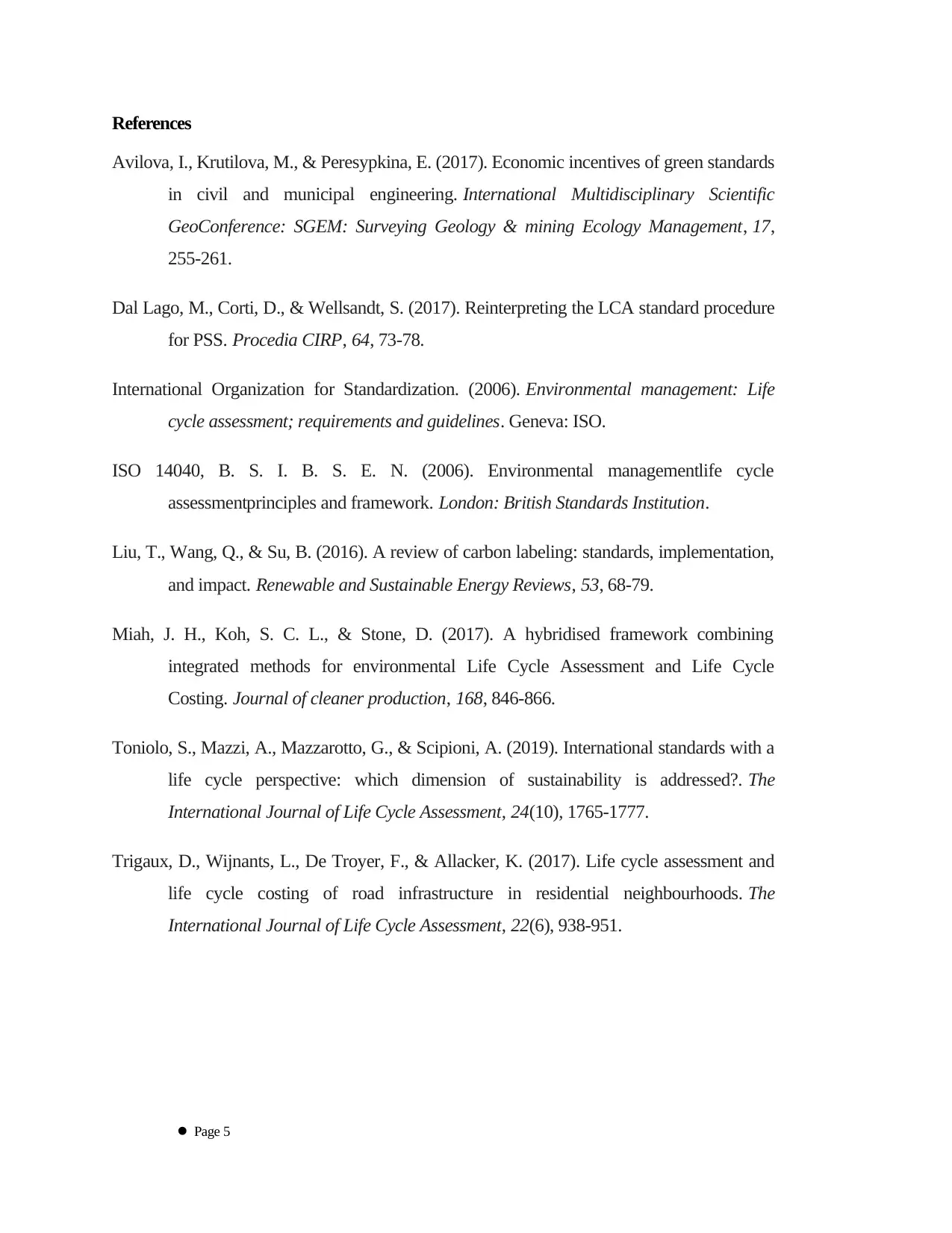
References
Avilova, I., Krutilova, M., & Peresypkina, E. (2017). Economic incentives of green standards
in civil and municipal engineering. International Multidisciplinary Scientific
GeoConference: SGEM: Surveying Geology & mining Ecology Management, 17,
255-261.
Dal Lago, M., Corti, D., & Wellsandt, S. (2017). Reinterpreting the LCA standard procedure
for PSS. Procedia CIRP, 64, 73-78.
International Organization for Standardization. (2006). Environmental management: Life
cycle assessment; requirements and guidelines. Geneva: ISO.
ISO 14040, B. S. I. B. S. E. N. (2006). Environmental managementlife cycle
assessmentprinciples and framework. London: British Standards Institution.
Liu, T., Wang, Q., & Su, B. (2016). A review of carbon labeling: standards, implementation,
and impact. Renewable and Sustainable Energy Reviews, 53, 68-79.
Miah, J. H., Koh, S. C. L., & Stone, D. (2017). A hybridised framework combining
integrated methods for environmental Life Cycle Assessment and Life Cycle
Costing. Journal of cleaner production, 168, 846-866.
Toniolo, S., Mazzi, A., Mazzarotto, G., & Scipioni, A. (2019). International standards with a
life cycle perspective: which dimension of sustainability is addressed?. The
International Journal of Life Cycle Assessment, 24(10), 1765-1777.
Trigaux, D., Wijnants, L., De Troyer, F., & Allacker, K. (2017). Life cycle assessment and
life cycle costing of road infrastructure in residential neighbourhoods. The
International Journal of Life Cycle Assessment, 22(6), 938-951.
Page 5
Avilova, I., Krutilova, M., & Peresypkina, E. (2017). Economic incentives of green standards
in civil and municipal engineering. International Multidisciplinary Scientific
GeoConference: SGEM: Surveying Geology & mining Ecology Management, 17,
255-261.
Dal Lago, M., Corti, D., & Wellsandt, S. (2017). Reinterpreting the LCA standard procedure
for PSS. Procedia CIRP, 64, 73-78.
International Organization for Standardization. (2006). Environmental management: Life
cycle assessment; requirements and guidelines. Geneva: ISO.
ISO 14040, B. S. I. B. S. E. N. (2006). Environmental managementlife cycle
assessmentprinciples and framework. London: British Standards Institution.
Liu, T., Wang, Q., & Su, B. (2016). A review of carbon labeling: standards, implementation,
and impact. Renewable and Sustainable Energy Reviews, 53, 68-79.
Miah, J. H., Koh, S. C. L., & Stone, D. (2017). A hybridised framework combining
integrated methods for environmental Life Cycle Assessment and Life Cycle
Costing. Journal of cleaner production, 168, 846-866.
Toniolo, S., Mazzi, A., Mazzarotto, G., & Scipioni, A. (2019). International standards with a
life cycle perspective: which dimension of sustainability is addressed?. The
International Journal of Life Cycle Assessment, 24(10), 1765-1777.
Trigaux, D., Wijnants, L., De Troyer, F., & Allacker, K. (2017). Life cycle assessment and
life cycle costing of road infrastructure in residential neighbourhoods. The
International Journal of Life Cycle Assessment, 22(6), 938-951.
Page 5
1 out of 5
Related Documents
Your All-in-One AI-Powered Toolkit for Academic Success.
+13062052269
info@desklib.com
Available 24*7 on WhatsApp / Email
![[object Object]](/_next/static/media/star-bottom.7253800d.svg)
Unlock your academic potential
Copyright © 2020–2025 A2Z Services. All Rights Reserved. Developed and managed by ZUCOL.





